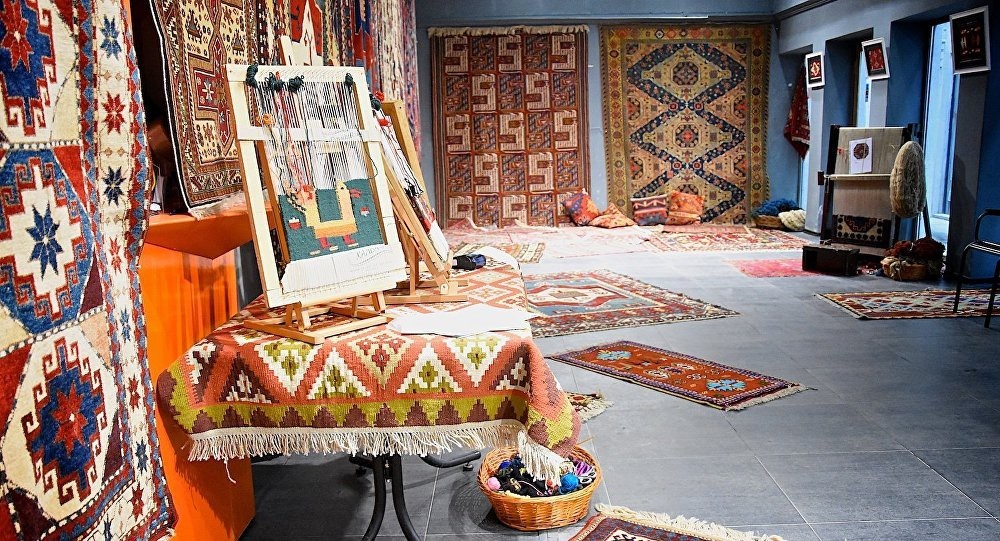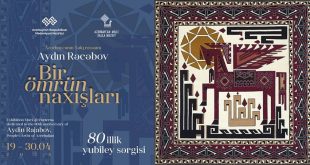
The Azerbaijani carpet is distinguished by a variety of types and subtypes. The typological richness of the Azerbaijani carpet, along with historical and ethnocultural factors, is associated with the unique diversity of natural and climatic conditions, which also contributed to the development of carpet weaving.
Azerbaijan carpets are traditionally divided into four types, so-called “carpet schools”, all of which have distinct characteristics.
These carpet schools are as follows:
Guba-Shirvan with manufacturing centers in Guba, Shirvan region and Baku;
Ganja-Kazakh, with centers in Ganja city and Kazakh region;
Karabakh (with major centers in Shusha, surrounding villages; and
Tabriz with centers in Tabriz and Ardabil in South (Iranian) Azerbaijan.
The carpets from various regional types differ by three features: ornaments, manufacturing technique and the kind of article in question. Karabakh carpets comprise 33 different compositions in total. Some of the were partly borrowed from the Tabriz and Iranian carpet schools, some are completely original.
The Karabakh carpet school have traditionally developed in two areas: in lowland and mountainous parts of Karabakh.
The city of Shusha and the villages of Dashbulag, Dovshanli, Girov, Trniviz, Malibayli, Chanakhcha, Tug, Taglar, Hadrut, Muradkhanli, Gasimushagi, Gubadli, Gogaz, Mishsaid, Bagirbayli, Khanlig and Tutmasli dominated the mountainous center of production in the 19th century. The peculiarity of the mountain center is that carpet production in villages was less developed than in Shusha.
In the low-lying areas, undoubtedly the dominant centers better provided with raw materials were Jabrayil, Agdam, Barda and Fizuli. Around each of these cities, there are many villages where the population was engaged in the production of carpets for sale. Such types of carpets as “chelebi”, “aran”, “goja”, “achmayumma”, “shabalid-buta”, “bakhmanli” and “mugan” were woven here.
The carpets of the Zangilan, Talish-Lankaran and Nakhchivan production centers also belong to the Karabakh type.
The Karabakh zone is famous for both pile and lint-free carpets, as well as carpet products. Karabakh carpet weavers developed and used a wide variety of compositions, some of which appeared as a result of the creative processing of compositions created in the Tabriz and Ardabil carpet weaving centers.
These carpets can be large or small. The “dast-haligaba” carpet sets, which were in great demand on the domestic and foreign markets, were especially popular. Karabakh produced carpets with both low pile and high density of knitting, as well as less dense carpets with high pile. The former were more typical for Shusha and for low-lying industrial points, and the latter for mountainous ones. Karabakh produced medallion, subject and ornamental carpets. The most widespread compositions were “buynuz”, “balig”, “daryanur”, “bakhchada-gullar”, “sakhsida-gullar”, “khanlig”, “khantirme”, “gasim-ushagi”, “minakhani” and “bulut”.
Besides usual carpets, carpet bags and coverlets of different types were widely spread. These included pileless mafrash (a trunk); khurdjun (a doubled travel bag); heiba (travelling bag); chuval (sacks for holding loose products); chul (all kinds of coverlets); yahar ustu (saddle cover) and other objects.
Carpet-weaving was historically a major traditional profession for the majority of feminine population of Karabakh. However, among the prominent Karabakh carpet weavers there were men too.
Today, Baku’s National Carpet Museum is a popular tourist attraction, but also a place of academic research. Austrian architect Franz Janz’s building takes the shape of a rolled-up carpet, and it occupies a prominent position in the heart of the city, in Baku’s seafront park. The museum has the world’s largest collection of Azerbaijani carpets, explains the history and processes of carpet making, and has galleries dedicated to other crafts.
Azerbaijani carpets are also included in the collections of various well-known museums, particularly in the Museum of Victoria and Albert (London), the Textile Museum (Washington), the Metropolitan Museum (New York), Museum Poldi Pezzoli (Milan), the Louvre (Paris), etc. The carpet collections have been studied and published (Chenchiner, R. Azerbaijani Carpets in the Victoria and Albert Museum).
 Oval Useful news from Azerbaijan and Caucasus
Oval Useful news from Azerbaijan and Caucasus


